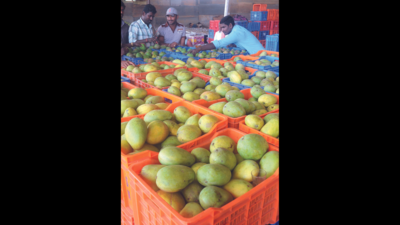- News
- City News
- lucknow News
- Lucknow: Heatwave ruins 80% crop in Malihabad mango belt
Lucknow: Heatwave ruins 80% crop in Malihabad mango belt

The association said that the price could even touch Rs 100 per kilogram as soon as the ripened fruits (the naturally ripened ones) hit the market around June 10.
LUCKNOW: Abnormal weather and extreme heat in March and April have taken a toll on the mango crop this year. The All India Mango Growers’ Association has pegged the loss at a whopping 80% for this year’s mango crop across the state, including Lucknow’s Dussehri belt, Malihabad.
The direct impact will be on the price of different varieties of mango, with none of them selling for less than Rs 70-80 per kilogram. The association said that the price could even touch Rs 100 per kilogram as soon as the ripened fruits (the naturally ripened ones) hit the market around June 10.

“This year, the mango crop was exposed to high temperatures at the growing stage. This temperature was actually required at the stage of ripening,” said Insram Ali, president of the association.
‘Saving grace is excellent quality of mango this yr’
“The saving grace is the excellent quality of the fruit this year. It is big in size and has spotless skin. But that does not take away from the fact that production is abysmally low this year,” he said.
“Against the normal production of around 40 lakh metric tonnes, this year it is between 8 lakh metric tonnes and 10 lakh metric tonnes. This holds true for all mango varieties. We are getting similar reports from Saharanpur, Bijnor, Hardoi and all other mango belts. When Dussehri, which accounts for 80% of the total mango production in UP, is hit, other varieties are bound to be affected too,” Ali said, adding that low production would affect the export of mangoes.“High prices will not make export profitable for growers,” Ali added.
President of the Malihabad Phal Mandi Samiti, Naseem Baig, said the panicles (‘baur’ or cluster of flo-wers) got destroyed due to heat. “A mango tree yields a good quantity of fruit every alternate year. Going by its cycle, Malihabad mango belt, the biggest producer of Dussehri in UP, is in its ‘off year’. The production was already low and weather has dealt another blow,” he said.
Mango crops are very sensitive to weather changes during the flowering stage.
Weather conditions affect panicles which is the very first stage of the crop and usually occurs in January. This year, even the winter was harsh which delayed the mango cycle. Rise in temperature in March and April aggravated the damage.
UP has at least four lakh hectare land which is under mango cultivation in north and central parts of the state. UP is the second largest mango producing state after Andhra Pradesh and the biggest producer of Dussehri.
The direct impact will be on the price of different varieties of mango, with none of them selling for less than Rs 70-80 per kilogram. The association said that the price could even touch Rs 100 per kilogram as soon as the ripened fruits (the naturally ripened ones) hit the market around June 10.

“This year, the mango crop was exposed to high temperatures at the growing stage. This temperature was actually required at the stage of ripening,” said Insram Ali, president of the association.
‘Saving grace is excellent quality of mango this yr’
“The saving grace is the excellent quality of the fruit this year. It is big in size and has spotless skin. But that does not take away from the fact that production is abysmally low this year,” he said.
“Against the normal production of around 40 lakh metric tonnes, this year it is between 8 lakh metric tonnes and 10 lakh metric tonnes. This holds true for all mango varieties. We are getting similar reports from Saharanpur, Bijnor, Hardoi and all other mango belts. When Dussehri, which accounts for 80% of the total mango production in UP, is hit, other varieties are bound to be affected too,” Ali said, adding that low production would affect the export of mangoes.“High prices will not make export profitable for growers,” Ali added.
President of the Malihabad Phal Mandi Samiti, Naseem Baig, said the panicles (‘baur’ or cluster of flo-wers) got destroyed due to heat. “A mango tree yields a good quantity of fruit every alternate year. Going by its cycle, Malihabad mango belt, the biggest producer of Dussehri in UP, is in its ‘off year’. The production was already low and weather has dealt another blow,” he said.
Mango crops are very sensitive to weather changes during the flowering stage.
Weather conditions affect panicles which is the very first stage of the crop and usually occurs in January. This year, even the winter was harsh which delayed the mango cycle. Rise in temperature in March and April aggravated the damage.
UP has at least four lakh hectare land which is under mango cultivation in north and central parts of the state. UP is the second largest mango producing state after Andhra Pradesh and the biggest producer of Dussehri.
FOLLOW US ON SOCIAL MEDIA
FacebookTwitterInstagramKOO APPYOUTUBE
Looking for Something?

Start a Conversation
end of article
Visual Stories
Quick Links
UP NewsDelhi TemperatureChennai WeatherBangalore TemperatureMoose wala DeathCoronavirus in DelhiRTPCR test in GurgaonHyderabad RainPollution level in BangaloreDelhi SmogDelhi TemperatureNoida AQIGurgaon AQI todayFire in MumbaiMumbai RainsCovid 19 RT PCR Test in NoidaDelhi AQI todaySrinagar encounter

